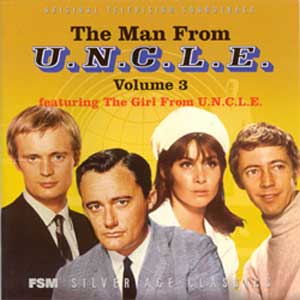The Man from U.N.C.L.E. – Volume 3 (featuring The Girl from U.N.C.L.E)
Music by Jerry Goldsmith, Morton Stevens, Gerald Fried, Robert Drasnin, Lalo Schifrin, Richard Shores and Dave Grusin
Original Television Soundtrack: Special Limited Edition (2 CD Set)
Available on FSMCD Vol. 7, No. 14
Running Time: 154:34 (total)
Disc One (The Man from U.N.C.L.E.): 77:21
Disc Two (The Girl from U.N.C.L.E.): 77:03
Purchase from: FSM Vol 7, No.14
Film Score Monthly, 8503 Washington Boulevard, Culver City, CA90232; Tel: 1-888-345-6335; overseas: 310-253-9595; fax: 310-253-9588 e-mail: Info@filmscoremonthly.com

See also:
Alias For those that have never heard of the series, The Man from U.N.C.L.E., simply think of James Bond, Maxwell Smart, or the Avengers and you will get the gist. Without ever watching the television series or growing up in the 60s, it is near impossible for me to say how I would have naturally reacted to the pop cultural mania of that decade. However, via aural sojourns with silver age classic releases provided by Film Score Monthly, I can get a decent glimpse into what can ultimately be summed up in a single adjective, “groovy”.
In the early 1960s, successful television producer Norman Felton was enamored by the Ian Fleming’s James Bond series and pitched to the author his concept for a newfangled adventure TV series featuring espionage and international intrigue. Shortly after accepting, Fleming dropped from the project due to contractual complications with the then-pending Bond movies, but not without leaving behind the names “Napoleon Solo” and “April Dancer.” Felton later brought aboard creator, producer, and writer, Sam Rolfe, to flesh out what would become The Man from U.N.C.L.E. Napoleon Solo became the name of the lead heroic spy (a hybrid of Bond and Cary Grant’s Roger Thornhill from North by Northwest), Illya Kuryakin as his Russian partner (a shock considering tenuous international relations imposed by the Cold War), and April Dancer was made into his Moneypenny-esque secretary. Biographical details of the characters were to be revealed bit by bit throughout the season for the sake of suspense. When the series debuted in September of 1964, the mysterious characters worked for U.N.C.L.E. (United Network Command for Law and Enforcement) to maintain political and legal order anywhere the world. U.N.C.L.E.’s primary nemesis was another organization known in the series only as T.H.R.U.S.H. — or as an author (David McDaniel) of later U.N.C.L.E. novels later put it, the “Technological Hierarchy for the Removal of Undesirables and the Subjugation of Humanity.”
Airing one hundred and five episodes and producing a spin-off, the series ran for four seasons before dying in 1968 on network television. Why? While The Man from U.N.C.L.E. started as a semi-serious show, things took a fatal turn for “camp” mid-second season after the much vaunted comic-to-TV series, Batman, caught fire and blasted standards of quality into the stone ages. Ratings may have dropped severely due to the style of presentation, but in the aftermath of change, music compositions flourished creatively.
The majority of this two-disc Special Limited Edition is compiled of episodic highlights from season one and two with a smatter of season three cues (disc one) and tracks from the spin-off known as The Girl from U.N.C.L.E. (disc two). There are also a handful of suites and medleys by Jerry Goldsmith, Gerald Fried, and Richard Shores. There are over two and a half hours worth of music to accompany the typical FSM special edition liner notes; a thick-book analysis of the show’s music and composer history along with glossies, and a track-by-track review.
Although it is highly irregular considering television shows today, listeners get to sample the music of a number of composers working with (more or less) the same subject matter. The phenomenal, trendsetting theme by Goldsmith notwithstanding, this is mélange of composers is perhaps the best thing about the entire album. For example, Goldsmith’s theme is original and versatile enough that composer Dave Grusin was able to invoke the jazzy, big band swank of Henry Mancini for his own compositions in The Girl from U.N.C.L.E. Nevertheless, one can almost believe that the scores were composed by a single person while listening from beginning to end.
Cynthia Walker, author of the impending Work/Text: Investigating The Man from U.N.C.L.E., states that ‘The music often reflects the characters’ inner psychological states…’ Well, much like the current hit spy show on television, Alias, the music in this series characterizes much more than what is shown on screen. The change from serious to extreme camp is shaped by the individual styles of Morton Stevens, Gerald Fried, Robert Drasnin, Lalo Schifrin, and Richard Shores; the works of such varying composers manage to transcend the visuals to bring tonal understanding and clear scene depictions to listeners. As the music unfolds, the events are played out so well by creative arrangements that it is almost as if you’re there — yes, in the 60s — watching the episodes.
Several notable tracks of many for volume three of The Man from U.N.C.L.E.: composer medleys, the theme, “Meet Mr. Solo”, “Belly Laughs”, “U.N.C.L.E. A Go Go”, “The Fiddlesticks Affair” (reminiscent of Ferrante and Teicher), “The Dog-Gone Affair”, and “The Mata Hari Affair.” The music could ostensibly be labeled “period kitsch” by those unaccustomed to the style, but it takes a little more than one run-through to pick up on the subtleties and artistry of the works. However, for an unadulterated 60s time-warp experience, fans of Goldsmith, Dave Grusin, or the show, should enjoy this limited collector’s item (and previous volumes) from Film Score Monthly. Tina Huang
31/2
Return to Index